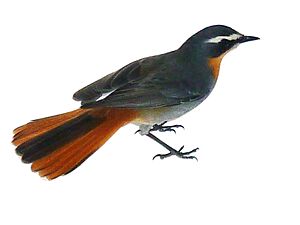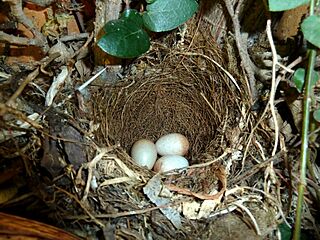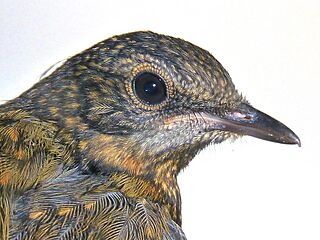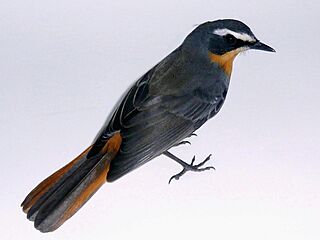Cape robin-chat facts for kids
Quick facts for kids Cape robin-chat |
|
|---|---|
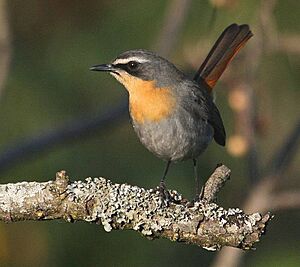 |
|
| In Pietermaritzburg, South Africa | |
| Conservation status | |
| Scientific classification | |
| Genus: |
Dessonornis
|
| Species: |
caffer
|
 |
|
|
range
|
|
The Cape robin-chat (Dessonornis caffer) is a small bird that sings, belonging to the Old World flycatcher family. It lives in different parts of Africa, from South Sudan all the way down to South Africa.
This friendly bird is often seen near people. It has learned to live well in places changed by humans, like city gardens and farm areas. Like other robin-chats, it sings beautifully. However, it's not as colorful as some of its relatives. It prefers drier places or higher mountains. It usually looks for food near bushes or trees, but also in open, well-lit spots. It likes the edges of mountain forests where there are ferns and thorny bushes. It doesn't go deep into the forest.
Contents
About the Cape Robin-Chat
The Cape robin-chat was officially named in 1771 by a Swedish scientist named Carl Linnaeus. He gave it the scientific name Motacilla caffra. The name caffra means "from South Africa" in Latin. This bird used to be in a different group called Cossypha. But now, it's one of four birds in the group Dessonornis, which was created in 1836 by Andrew Smith.
Different Types of Cape Robin-Chats
Scientists generally agree there are four main types, or subspecies, of Cape robin-chats. These types live in different areas and are slightly different from each other.
- D. c. iolaemus – Found from southern South Sudan to Malawi and northern Mozambique. You can also find them in Kenya, Tanzania, and eastern Uganda.
- D. c. kivuensis – Lives in southwest Uganda, northwest Tanzania, and the DRC.
- D. c. namaquensis – Found in the Northern Cape of South Africa and southern Namibia. These birds are a bit bigger and have a wider white stripe above their eye.
- D. c. caffer – Lives in eastern Zimbabwe, South Africa, Eswatini, and Lesotho. These birds can live from sea level up to 3,000 meters high.
What They Look Like
Male and female Cape robin-chats look very similar. They are about 16–17 centimeters long, from their beak to the tip of their tail. They weigh about 28 grams.
Their upper body is grey, with a hint of brownish-olive on their back and wing feathers. They have blackish patches around their eyes and ears. A clear white stripe above their eye separates these black patches from the top of their head. Their chin, throat, chest, rump, and the outer feathers of their tail are orange. The orange on their chest gets even brighter during the non-breeding season. The middle tail feathers are greyish-brown. When the tail is closed, these grey feathers hide the bright orange outer feathers. Their belly is light grey to white.
Young Cape robin-chats have tails like the adults. But they don't have the white stripe above their eye. Their upper body is dark brown, and their underside is buff-colored. They have many buff marks on their upper body and grey-brown marks on their chest. Their legs and feet are pinkish-grey. Unlike other robin-chats, the bottom of their feet are yellow.
Sounds and Songs
The Cape robin-chat has a loud, harsh alarm call that sounds like "WA-dur-dra" or "TURR-da-da." This call has given them local names like "Jan frederik." They also make this call when they arrive at or leave their sleeping spot.
Their song is clear and rings out in short phrases. Sometimes, two males will sing at the same time. They sing most often at dawn and dusk. Their song is a series of whistled sounds, like "cherooo-weet-weet-weeeet," followed by a pause. Each part of the song has 4 to 10 sounds. It starts with a low whistle and then has many different whistled notes. They often sing from inside a tree or bush, near the top, for an hour or more. They can even sing late into the evening, in the dark.
If a bird is worried, it makes a sad, falling "peeeeeuu" sound. This happens, for example, if their babies are in danger. Like other robin-chats, they can copy the sounds of other birds. One bird was even heard mimicking 36 different bird species!
Where They Live
The Cape robin-chat lives in many countries in Africa. You can find them from South Sudan (in the Imatong Mountains) down to Uganda, the DRC, Kenya, Tanzania, Zambia, Malawi, Zimbabwe, Namibia, South Africa, Eswatini, and Lesotho.
Most of these birds stay in the same area year-round. But some adults and young birds might move more than 100 kilometers to warmer, lower areas in winter. Even at high altitudes, some birds stay in the same place all year. A pair of Cape robin-chats often stays in the same breeding area for five years. The longest recorded lifespan for one of these birds is over 16 years.
In southern Africa, the Cape robin-chat is common. It lives at the edges of mountain forests, in forest bushes, and in gardens and parks. Any area with thick bushes and a few trees for singing is usually good for them. In dry areas, they only live near thick bushes along rivers. They are not found in the very dry Karoo and Kalahari deserts.
In tropical East Africa, they also live at forest edges and in gardens. But they are only found in the higher mountain areas. They can live up to 3,400 meters high.
How They Behave
Cape robin-chats usually move around alone, hopping on the ground. They often sit on high, easy-to-see spots. They also sleep alone in thick bushes, about 3 meters off the ground. They often flick their tail up to a 60-degree angle. When they land, they might quickly flap their wings and fan their tail. They bathe every day, even in small pools left by the ocean tide.
What They Eat
Cape robin-chats usually look for food on or near the ground. But sometimes, they will pick insects off tree bark and leaves in tall trees. They like to stay hidden by plants, but they are not very shy. They find insects, small frogs, and lizards in bushes or among fallen leaves. They also eat fruits and seeds from plants or off the ground. Sometimes, they catch an insect in the air.
How They Raise Their Young
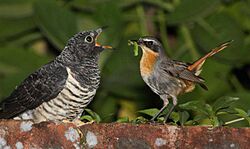
Cape robin-chats are monogamous, meaning one male and one female stay together. They are very protective of their nesting area. Their territory is usually a small piece of land, but its size can change depending on where they live. They build their nests very close to the ground, usually within 0 to 2 feet. The nest might be against a tree trunk or on a broken stump, often hidden by plants hanging over it.
Cape robin-chats usually nest from June to November in the Western Cape. In other areas, they nest from August to January. But they can nest at any time of the year. One bird will wet its belly feathers and use the moisture to soften the nest material. The other bird will bring the material to the nest. The female builds a cup-shaped nest from rough plants. She lines it with animal hair, small roots, and other soft materials. It takes 6 to 14 days to build the nest.
They lay two to three eggs, one every day. The female sits on the eggs for 14 to 19 days to keep them warm. The eggs are about 13 x 17 millimeters in size. They can be off-white, pinkish, or light blue. They always have rusty-brown spots, especially near the wider end. Both parents feed the baby birds for 14 to 18 days after they hatch. They continue to feed them for 5 to 7 weeks after they leave the nest.
Cape robin-chats can start breeding when they are two years old. But it often happens later because good nesting spots are usually already taken. Sometimes, a red-chested cuckoo will lay its egg in a Cape robin-chat's nest. The robin-chat then raises the cuckoo chick, thinking it's their own. Predators often raid the nests, so the robin-chats often have to build new nests.
Gallery
-
Nest with three eggs, placed in a creeping fig plant.



